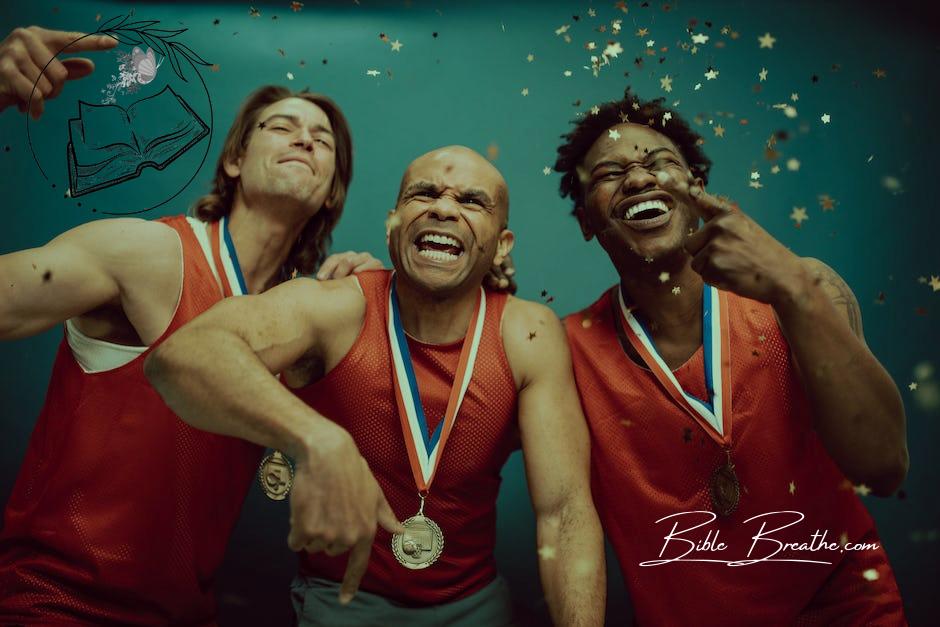Who hung beside Jesus on that cross?
It’s like peeking into a divine epic, my friends, where two souls took their final breaths, making choices that echoed through eternity.
One man, Dismas, he was the one who said, “Lord, remember me when You come into Your kingdom.”
That’s some serious last-minute repentance, right?
He’s our poster child for redemption.
Now, Gestas, on the other side, was unrepentant, unmovable in his ways.
It’s like looking at two paths laid out before us – one leading to salvation, the other, well, not so pretty.
It’s not just a story; it’s a message, a lesson that resonates through the ages.
These two, they show us that no matter how far gone we may think we are, there’s always a chance for a U-turn on the road to heaven.
It’s a story of grace, transformation, and the promise of a better tomorrow.
🙏🌟
Key Takeaways
- The contrasting reactions of Dismas and Gestas, the two individuals crucified alongside Jesus, present a powerful illustration of choice and destiny. Dismas, filled with remorse and a recognition of Jesus’ innocence, found redemption and eternal life through his repentant heart. On the other hand, Gestas, in his bitterness and disbelief, faced the consequences of rejecting the Savior.
- The story of Dismas and Gestas provides timeless lessons on repentance and redemption. It emphasizes the capacity for transformation and forgiveness, regardless of one’s past. Dismas’ last-minute repentance and Jesus’ response reveal God’s boundless grace and the opportunity for salvation, even in the eleventh hour.
- Understanding and teaching biblical stories, like that of Dismas and Gestas, is crucial for nurturing faith and imparting moral and spiritual lessons. These narratives serve as a foundation for understanding human nature, redemption, and the profound love and mercy of God. Sharing these stories helps shape individuals’ beliefs, values, and choices in their faith journey.
- Dismas and Gestas’ contrasting fates remind us of the critical role of personal choice and the importance of embracing grace and repentance. Their story challenges us to examine our own hearts and choose the path of redemption and faith, echoing the offer of eternal life extended by Jesus on the cross.
The Two Thieves on the Cross: Dismas and Gestas
Photo modified by BibleBreathe.com. Original photo by Anna Shvets on Pexels
Picture this: a scene painted with shadows, where the sun’s dying rays cast an eerie but profound light on Golgotha, the hill of the skull.
Here, amidst the agonizing gasps and mournful cries, hung three figures, each carrying a tale of sin and redemption heavy as lead.
Meeting Dismas and Gestas
On that momentous day, two men met their fate alongside Jesus of Nazareth, all condemned to meet their end on wooden crosses.
One of them was Dismas, a name that whispers of hope.
His life had been a tangle of sin and mistakes, once a bandit seeking redemption in those final breaths.
Then there was Gestas, a name that carries the weight of guilt, representing a life led astray and unrepentant.
Their names alone signaled the stark difference in their destinies.
The Greek Significance of their Names
In ancient Greek, the name Dismas carries the essence of “sunset” or “death,” a poignant reflection of the time he faced his own demise on that cross.
On the flip side, Gestas can be tied to the word “gestas,” which means “evil deeds” or “acts of infamy,” painting a vivid picture of the life he had led.
“And Jesus said unto him, Verily I say unto thee, Today shalt thou be with me in paradise.” – Luke 23:43 (KJV)
How they are Portrayed in Religious Texts and Art
Through centuries of artistic interpretation and biblical narration, these two thieves have captivated our curiosity and contemplation.
Dismas, often depicted with a repentant demeanor, embodies the possibility of salvation even in the eleventh hour.
Gestas, on the other hand, stands as a stark warning of unrepentant hearts and the consequences of a life lived without remorse.
In the grand tapestry of the crucifixion, the presence of these two thieves amplifies the message of grace, repentance, and the boundless mercy of a Savior.
Let this ancient tale remind us that it’s never too late to seek redemption.
Even in our darkest moments, grace and forgiveness await those who turn their hearts toward the light.
Unveiling the Companion on the Cross
Photo modified by BibleBreathe.com. Original photo by Anna Shvets on Pexels
Hey there, folks, PASTOR MICHAEL TODD here to walk you through a powerful moment in history – the crucifixion of Jesus Christ.
Now, crucifixion wasn’t your everyday punishment; it was a brutal and rare ordeal, especially in the Roman Empire.
Reserved for the boldest of rebels and the most serious offenders.
Crucifixion: A Rare and Harsh Roman Reality
Picture this: the condemned nailed to a cross, writhing in unimaginable pain.
It wasn’t just your run-of-the-mill punishment; it was designed to strike fear into the hearts of all who saw it.
Dismas: More Than a Common Thief
Now, among those who shared this agonizing fate with Jesus was a man named Dismas.
But Dismas wasn’t your average criminal; some folks even compare him to a modern-day “Robin Hood.”
His presence challenges our ideas of guilt and innocence.
“And Jesus said unto him, Verily I say unto thee, Today shalt thou be with me in paradise.” – Luke 23:43 (KJV)
Right there, at the foot of the cross, Dismas had a change of heart.
He owned up to his mistakes, seeking redemption.
He recognized the divinity of Jesus, and that moment of realization brought a glimmer of hope to his impending darkness.
Jesus responded with a promise of a place in paradise.
Lessons in the Midst of Calamity
Now, what can we learn from this encounter?
Well, the story of Dismas, the repentant bandit, standing next to Jesus, the blameless Messiah, holds a profound lesson.
It shows us that redemption is possible even in the darkest of times.
Through Dismas, we see that salvation reaches into the most unexpected corners of humanity.
As we ponder this ancient tale, it challenges our notions of guilt and innocence.
It calls us to seek repentance and salvation, even in the darkest moments of our lives.
Remember, my friends, there’s always hope for a fresh start, even when things seem their bleakest.
The Crucible of Divine Encounters on the Cross
Photo modified by BibleBreathe.com. Original photo by RDNE Stock project on Pexels
Imagine this scene: as the sun dipped toward the horizon, casting an enchanting deep orange glow, three figures took their place on the stage of Golgotha.
Amongst the gasps of agony and the crushing weight of humanity’s sins, there stood Jesus of Nazareth, flanked by two souls at a crossroads of destiny.
Dismas’s Revelation and His Cry for Redemption
In the shadow of suffering, Dismas, one of the thieves crucified alongside Jesus, had an epiphany.
Maybe it was the aura of love and forgiveness radiating from the sinless man beside him.
Perhaps it was how Jesus bore his agony with a divine grace that defied comprehension.
Amidst the torment, Dismas saw in Jesus a purity and innocence like no other.
In that profound moment of divine clarity, he made a plea that would reverberate through the ages.
“Lord, remember me when thou comest into thy kingdom.” – Luke 23:42 (KJV)
Gestas’s Scorn and Doubt in Jesus’s Divine Identity
On the flip side hung Gestas, consumed by bitterness and disbelief.
To him, a bloodied and broken man couldn’t possibly be the promised Messiah.
Pain and impending death fueled his anger, causing him to mock the one they called the King of the Jews.
Gestas taunted and hurled disbelief like stones, oblivious to the profound significance of the moment.
He remained ensnared by a hardened heart, blind to the salvation within arm’s reach.
Here, we witness the contrasting responses of the human heart when confronted by the divine—belief versus unbelief, acceptance versus denial.
Contrasting Fates of the Two Thieves
On the backdrop of Calvary, the destinies of these two thieves were sealed.
Dismas, despite a lifetime of transgressions, found his path to redemption through faith and acknowledgment of Jesus.
His plea was met with compassion, assuring him a place in paradise.
Meanwhile, Gestas, burdened by disbelief and a heart encased in stone, faced an eternity without salvation.
This stark contrast serves as a potent reminder that even in the face of suffering and death, our response to grace and our recognition of the divine can shape our destinies.
The cross stands as a testament to the power of faith, the potency of redemption, and the profound ability of a repentant heart to transform a fate once bound for darkness into an eternal destiny bathed in divine light.
Lessons from Dismas and Gestas: A Tale of Two Crosses
Photo modified by BibleBreathe.com. Original photo by Anastasia Shuraeva on Pexels
Hey there, friends, it’s PASTOR MICHAEL TODD, and we’re about to dive into a story that unfolds on the very hill known as Golgotha, the hill of skulls.
Here, you’ll find three crosses, each holding a profound symbol of human nature – our capacity for both wickedness and redemption.
The Crucifixion Chronicles: Dismas and Gestas
Now, let’s meet our characters, Dismas and Gestas, two common thieves, sharing the same destiny as Jesus, the Messiah.
But their paths to those crosses couldn’t be more different, like the directions of sunrise and sunset.
Suffering versus Repentance
Gestas, well, he let bitterness and defiance consume him.
He chose to suffer in silence and even hurled insults at Jesus, demanding a miracle.
In his agony, he missed the chance for transformation, holding onto that path of suffering.
But Dismas, amidst his suffering, found something incredible – the strength to repent.
He admitted his wrongs and humbly sought redemption.
His repentance opened the gates of paradise, securing his salvation, a powerful example of the impact of contrition.
“And he said unto Jesus, Lord, remember me when thou comest into thy kingdom.” – Luke 23:42 (KJV)
Timeless Moral Lessons
Now, here’s the takeaway: suffering doesn’t determine our fate; it’s how we respond to suffering that defines us.
Dismas showed us that even in our darkest moments, when pain feels overwhelming, redemption is within our grasp if we’re willing to reach for it.
Recognizing Mistakes and Seeking Forgiveness
And let’s not forget the importance of owning up to our mistakes and seeking forgiveness, just like Dismas did.
His sincere repentance and plea for grace highlighted the transformative power of humility and accountability.
This lesson echoes through time, reminding us that our path to righteousness begins with recognizing our wrongs and seeking divine forgiveness.
In this profound narrative, those crosses on Calvary aren’t just instruments of torture; they’re symbols of choice – the choice to embrace suffering and bitterness or the choice to repent, seek redemption, and find solace in the promise of a higher grace.
It’s a choice given to each one of us, urging us to walk the path of righteousness, even when faced with immense suffering.
Drawing Life Lessons from the Cross: A Handbook for Parents and Teachers
Photo modified by BibleBreathe.com. Original photo by Andrea Piacquadio on Pexels
Imagine this: the unfolding drama on Golgotha’s hill, where Jesus hung on the cross, flanked by two thieves.
This scene isn’t just for the faithful; it’s a treasure trove of wisdom for parents and teachers, those entrusted with shaping young hearts and minds.
Balancing Discipline and Understanding in Child Rearing
In the crucible of crucifixion, we witness the weight of punishment and the consequences of choices.
Dismas and Gestas faced the harsh reality of their actions, the bitter fruit of their decisions.
As parents and teachers, this serves as a vivid illustration of the importance of helping children understand that their choices have consequences.
But in this tale, we also find a profound lesson in mercy and understanding.
Even in His own agony, Jesus extended compassion to a repentant heart, underscoring the significance of mercy and forgiveness in the process of growth and transformation.
“Train up a child in the way he should go: and when he is old, he will not depart from it.” – Proverbs 22:6 (KJV)
Teaching Moral Values and the Power of Redemption
The story of the thieves at the cross is a potent tool for instilling moral values and the concept of repentance.
Dismas, recognizing his wrongs, reached out for redemption.
Gestas, mired in bitterness, missed this opportunity.
It’s crucial for parents and teachers to impart not only the importance of acknowledging one’s mistakes but also the possibility of redemption and personal growth.
The understanding that a repentant heart can find grace is a cornerstone of nurturing a compassionate and empathetic society.
In our roles as mentors and guides, let’s draw inspiration from this age-old narrative.
We must balance discipline with compassion, teach the consequences of actions while embracing mercy, and instill in young hearts the profound truth that, even in their darkest moments, a path to light exists through repentance and the embrace of grace.
Frequently Asked Questions (FAQs) About Who Died On The Cross Next To Jesus
Who were the two men crucified next to Jesus?
The two men crucified next to Jesus were criminals, often referred to as the ‘thieves’ or ‘robbers’ in the Gospels.
One of them showed remorse and received forgiveness from Jesus.
Why were Dismas and Gestas crucified?
Dismas and Gestas were crucified alongside Jesus.
Dismas, also known as the ‘Good Thief,’ expressed faith in Jesus on the cross, leading to his salvation.
Gestas, the ‘Bad Thief,’ remained defiant.
Their crucifixion illustrates the contrast between belief and unbelief.
What did Jesus say to Dismas on the cross?
Jesus told Dismas, one of the criminals crucified alongside him, ‘Truly I tell you, today you will be with me in paradise.’ This declaration revealed Jesus’ mercy and offered hope of redemption, demonstrating his ability to grant salvation even to those acknowledging their wrongdoings.
{
“@context”: “https://schema.org”,
“@type”: “FAQPage”,
“mainEntity”: [
{
“@type”: “Question”,
“name”: “Who were the two men crucified next to Jesus?”,
“acceptedAnswer”: {
“@type”: “Answer”,
“text”: “The two men crucified next to Jesus were criminals, often referred to as the ‘thieves’ or ‘robbers’ in the Gospels. One of them showed remorse and received forgiveness from Jesus.”
}
},
{
“@type”: “Question”,
“name”: “Why were Dismas and Gestas crucified?”,
“acceptedAnswer”: {
“@type”: “Answer”,
“text”: “Dismas and Gestas were crucified alongside Jesus. Dismas, also known as the ‘Good Thief,’ expressed faith in Jesus on the cross, leading to his salvation. Gestas, the ‘Bad Thief,’ remained defiant. Their crucifixion illustrates the contrast between belief and unbelief.”
}
},
{
“@type”: “Question”,
“name”: “What did Jesus say to Dismas on the cross?”,
“acceptedAnswer”: {
“@type”: “Answer”,
“text”: “Jesus told Dismas, one of the criminals crucified alongside him, ‘Truly I tell you, today you will be with me in paradise.’ This declaration revealed Jesus’ mercy and offered hope of redemption, demonstrating his ability to grant salvation even to those acknowledging their wrongdoings.”
}
}
]
}






